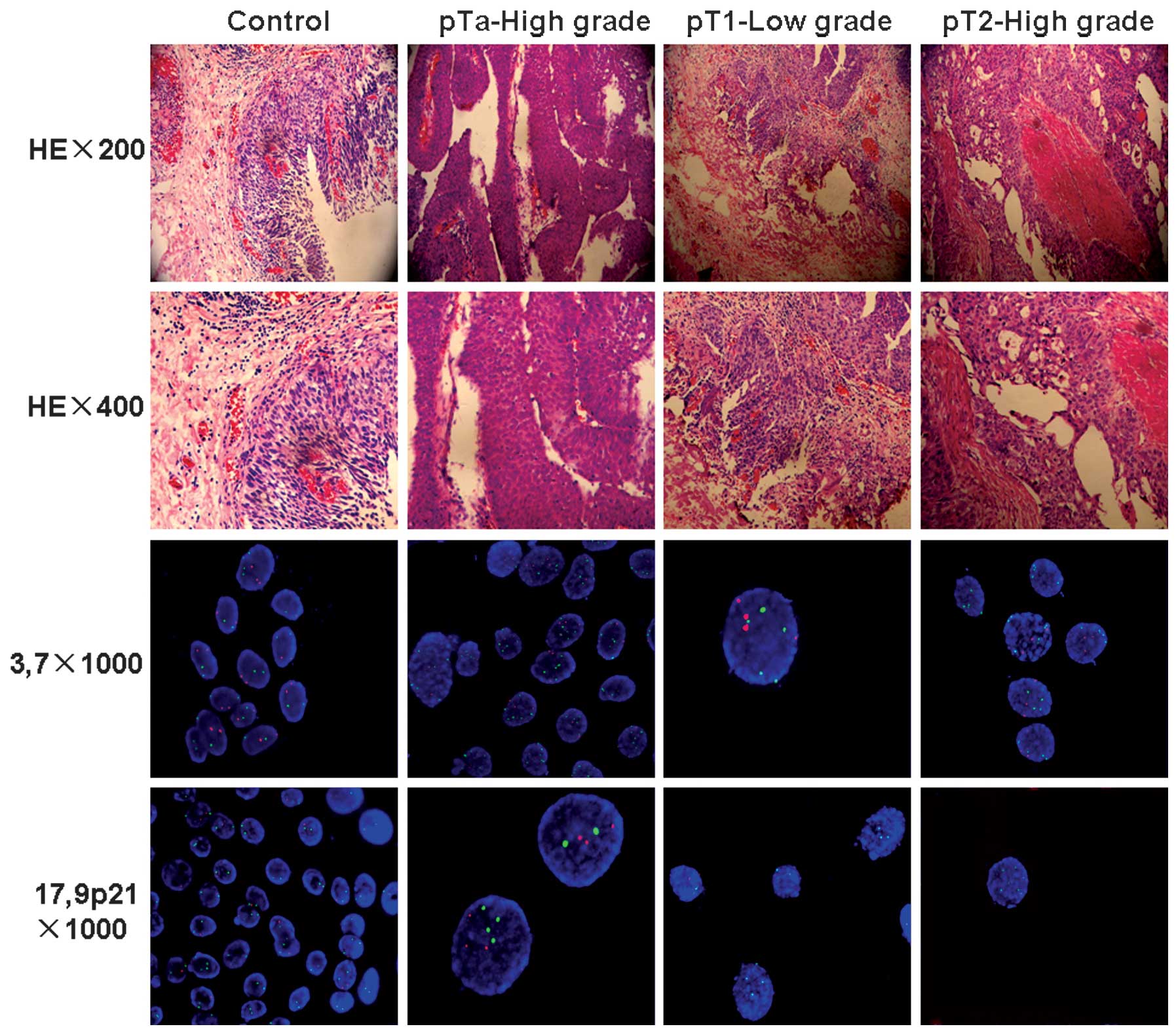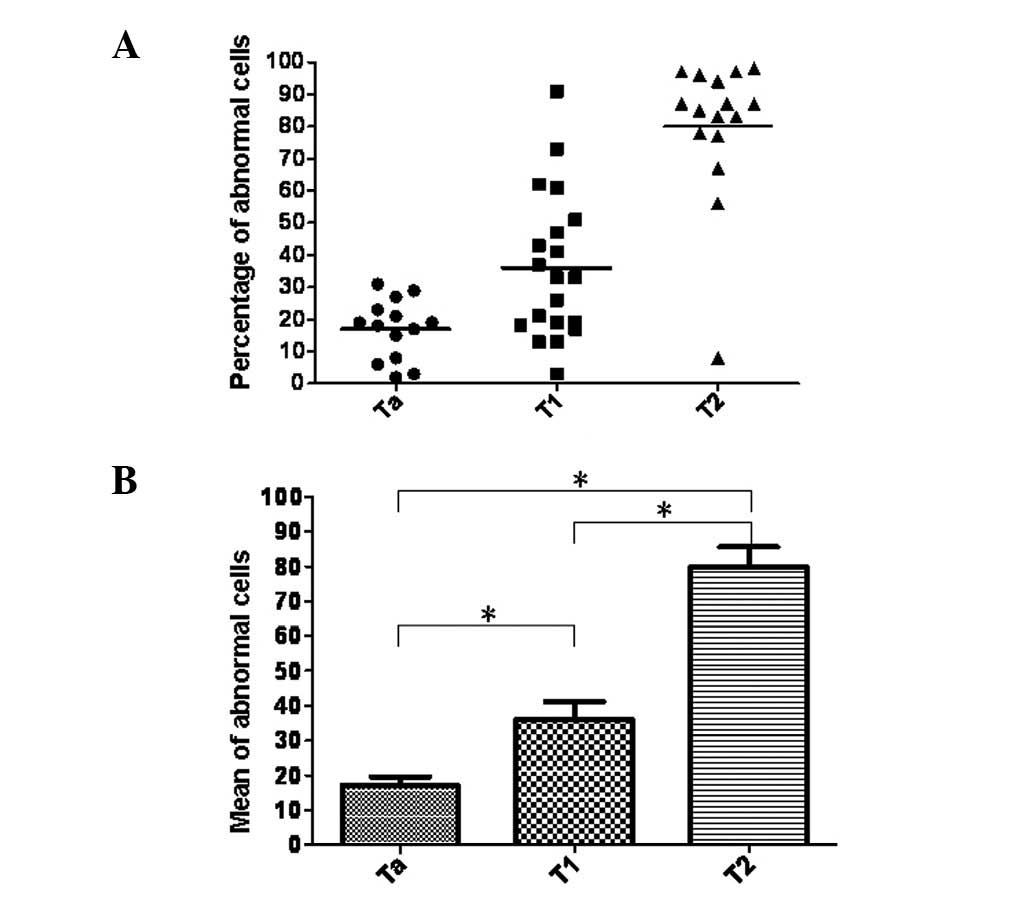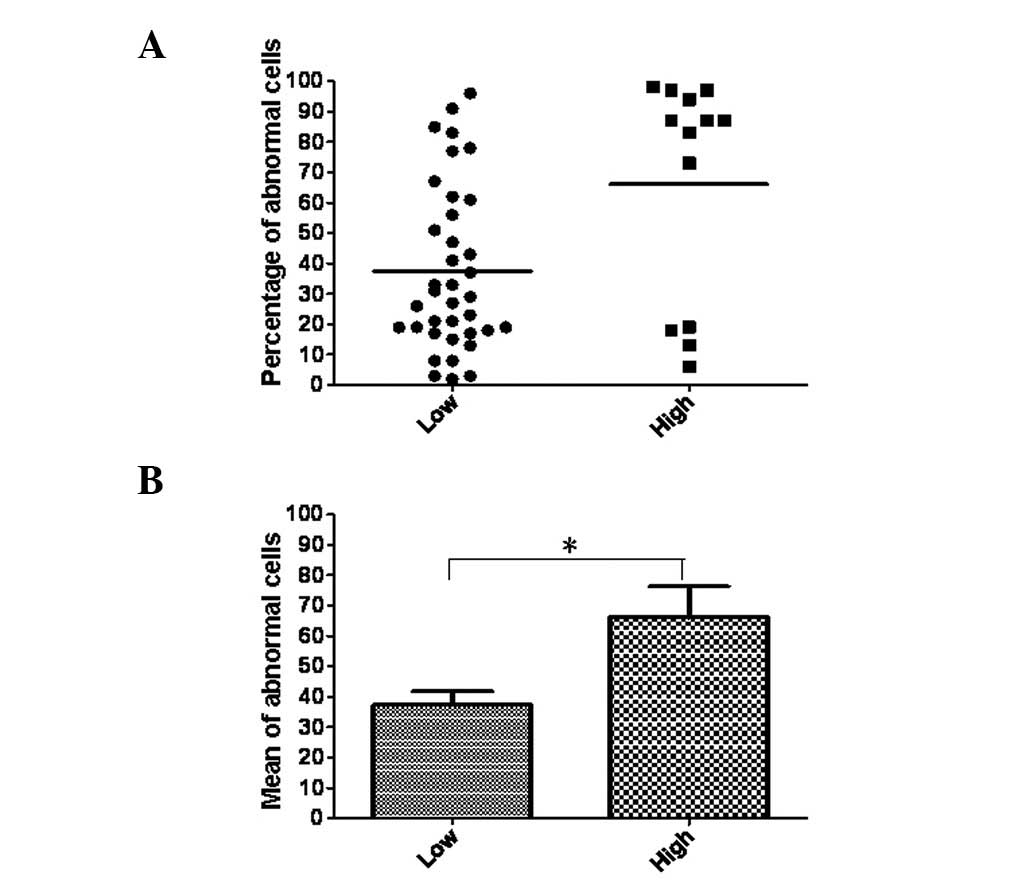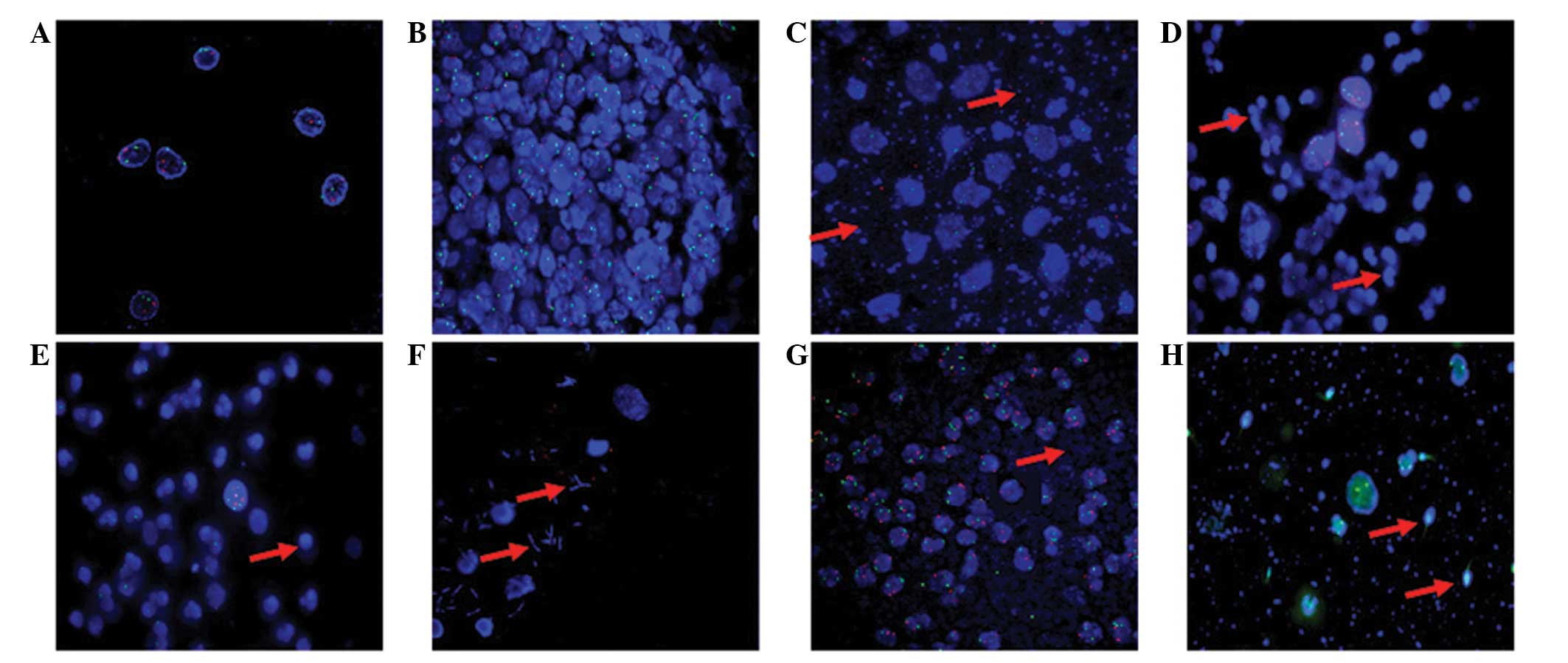|
1
|
Chamie K and Litwin MS: Quality of bladder
cancer care in the USA. Expert Rev Pharmacoecon Outcomes Res.
11:619–621. 2011. View Article : Google Scholar : PubMed/NCBI
|
|
2
|
Bellmunt J, Orsola A, Wiegel T, Guix M, De
Santis M, Kataja V, et al; ESMO Guidelines Working Group. Bladder
cancer: ESMO clinical practice guidelines for diagnosis, treatment
and follow-up. Ann Oncol. 22(Suppl 6): vi45–vi49. 2011. View Article : Google Scholar : PubMed/NCBI
|
|
3
|
Alameddine M and Nassir A: The influence
of urine cytology on our practice. Urol Ann. 4:80–83. 2012.
View Article : Google Scholar : PubMed/NCBI
|
|
4
|
Mian C, Lodde M, Comploj E, Negri G,
Egarter-Vigl E, Lusuardi L, et al: Liquid-based cytology as a tool
for the performance of uCyt+ and Urovysion
Multicolour-FISH in the detection of urothelial carcinoma.
Cytopathology. 14:338–342. 2003. View Article : Google Scholar : PubMed/NCBI
|
|
5
|
Dahmoush L and Cohen MB: FISHing and
beyond in urinary cytology. Diagn Cytopathol. 31:2012004.
View Article : Google Scholar : PubMed/NCBI
|
|
6
|
Lapray JF, Costa P, Delmas V and Haab F:
The role of ultrasound in the exploration of pelvic floor
disorders. Prog Urol. 19:947–952. 2009.(In French).
|
|
7
|
Mazo EB, Gazhonova VE and Chepurov DA:
Three-dimentional echography in diagnosis and staging of urinary
bladder cancer. Urologiia. May–Jun;6–12. 2005.(In Russian).
|
|
8
|
Hermann GG, Mogensen K, Toft BG, Glenthøj
A and Pedersen HM: Outpatient diagnostic of bladder tumours in
flexible cystoscopes: evaluation of fluorescence-guided flexible
cystoscopy and bladder biopsies. Scand J Urol Nephrol. 46:31–36.
2012. View Article : Google Scholar
|
|
9
|
Panani AD, Kozirakis D, Anastasiou J,
Babanaraki A, Malovrouvas D and Roussos C: Is aneusomy of
chromosome 9 alone a valid biomarker for urinary bladder cancer
screening? Anticancer Res. 26:1161–1165. 2006.
|
|
10
|
Leonardo C, Merola R, Orlandi G, Leonardo
F, Rondoni M and De Nunzio C: C-erb-2 gene amplification and
chromosomal anomalies in bladder cancer: preliminary results. J Exp
Clin Cancer Res. 24:633–638. 2005.PubMed/NCBI
|
|
11
|
Caraway NP, Khanna A, Fernandez RL, Payne
L, Bassett RL Jr, Zhang HZ, et al: Fluorescence in situ
hybridization for detecting urothelial carcinoma: a
clinicopathologic study. Cancer Cytopathol. 118:259–268. 2010.
View Article : Google Scholar : PubMed/NCBI
|
|
12
|
Chuang KL, Chuang HC, Ng KF, Chang YH, Wu
CT, Chuang CK, et al: Urinary fluorescence in situ hybridization
assay for detecting urothelial carcinoma in Taiwanese patients. BJU
Int. 105:1413–1416. 2010. View Article : Google Scholar : PubMed/NCBI
|
|
13
|
Reid-Nicholson MD, Ramalingam P, Adeagbo
B, Cheng N, Peiper SC and Terris MK: The use of Urovysion
fluorescence in situ hybridization in the diagnosis and
surveillance of non-urothelial carcinoma of the bladder. Mod
Pathol. 22:119–127. 2009. View Article : Google Scholar : PubMed/NCBI
|
|
14
|
Ploeg M, Aben KK and Kiemeney LA: The
present and future burden of urinary bladder cancer in the world.
World J Urol. 27:289–293. 2009. View Article : Google Scholar : PubMed/NCBI
|
|
15
|
Madeb R, Golijanin D, Knopf J, Davis M,
Feng C, Fender A, et al: Long-term outcome of patients with a
negative work-up for asymptomatic microhematuria. Urology.
75:20–25. 2010. View Article : Google Scholar : PubMed/NCBI
|
|
16
|
Glas AS, Roos D, Deutekom M, Zwinderman
AH, Bossuyt PM and Kurth KH: Tumor markers in the diagnosis of
primary bladder cancer. A systematic review. J Urol. 169:1975–1982.
2003. View Article : Google Scholar : PubMed/NCBI
|
|
17
|
Halling KC, King W, Sokolova IA, Karnes
RJ, Meyer RG, Powell EL, et al: A comparison of BTA stat,
hemoglobin dipstick, telomerase and Vysis UroVysion assays for the
detection of urothelial carcinoma in urine. J Urol. 167:2001–2006.
2002. View Article : Google Scholar
|
|
18
|
Galván AB, Salido M, Espinet B, Placer J,
Pijuan L, Juanpere N, et al: A multicolor fluorescence in
situ hybridization assay: a monitoring tool in the surveillance
of patients with a history of non-muscle-invasive urothelial cell
carcinoma: A prospective study. Cancer Cytopathol. 119:395–403.
2011.
|
|
19
|
Fritsche HM, Burger M, Dietmaier W,
Denzinger S, Bach E, Otto W, et al: Multicolor FISH (UroVysion)
facilitates follow-up of patients with high-grade urothelial
carcinoma of the bladder. Am J Clin Pathol. 134:597–603. 2010.
View Article : Google Scholar : PubMed/NCBI
|
|
20
|
Laudadio J, Keane TE, Reeves HM, Savage
SJ, Hoda RS, Lage JM and Wolff DJ: Fluorescence in situ
hybridization for detecting transitional cell carcinoma:
implications for clinical practice. BJU Int. 96:1280–1285.
2005.
|
|
21
|
Dumache R, David D, Kaycsa A, Minciu R,
Negru S and Puiu M: Genetic and epigenetic biomarkers for early
detection, therapeutic effectiveness and relapse monitoring in
bladder cancer. Rev Med Chir Soc Med Nat Iasi. 115:163–167.
2011.
|
|
22
|
Song MJ, Lee HM and Kim SH: Clinical
usefulness of fluorescence in situ hybridization for diagnosis and
surveillance of bladder cancer. Cancer Genet Cytogenet.
198:144–150. 2010. View Article : Google Scholar : PubMed/NCBI
|
|
23
|
Kwak KW, Kim SH and Lee HM: The utility of
fluorescence in situ hybridization for detection of bladder
urothelial carcinoma in routine clinical practice. J Korean Med
Sci. 24:1139–1144. 2009. View Article : Google Scholar : PubMed/NCBI
|
|
24
|
Waldman FM, Carroll PR, Kerschmann R,
Cohen MB, Field FG and Mayall BH: Centromeric copy number of
chromosome 7 is strongly correlated with tumor grade and labeling
index in human bladder cancer. Cancer Res. 51:3807–3813. 1991.
|
|
25
|
Sauter G, Simon R, Bubendorf L and
Mihatsch M: Molecular genetics of urinary bladder cancer
progression. Verh Dtsch Ges Pathol. 86:49–56. 2002.(In German).
|
|
26
|
Horstmann M, Patschan O, Hennenlotter J,
Senger E, Feil G and Stenzl A: Combinations of urine-based tumour
markers in bladder cancer surveillance. Scand J Urol Nephrol.
43:461–466. 2009. View Article : Google Scholar : PubMed/NCBI
|


















